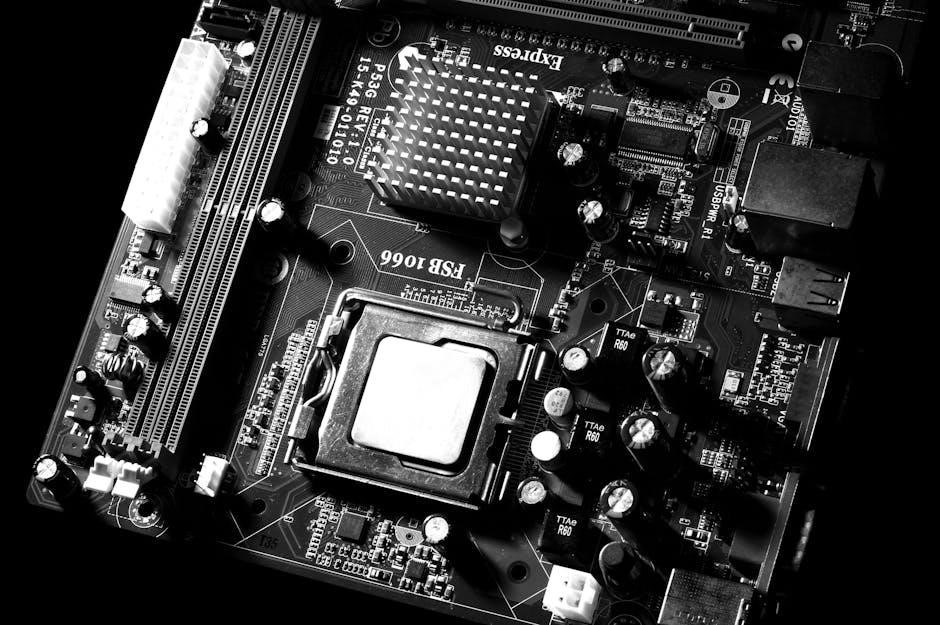The locomotor system enables movement, stability, and support, comprising the muscular and skeletal systems. It is essential for daily activities and overall well-being, protecting vital organs and facilitating mobility.
1.1 Definition and Overview
The locomotor system, also known as the musculoskeletal system, consists of bones, muscles, joints, and associated structures. It enables movement, stability, and support for the body. This system protects vital organs, facilitates mobility, and maintains posture. Its components work together to provide structural integrity and functional movement, making it essential for daily activities and overall well-being.
1.2 Components of the Locomotor System
The locomotor system comprises the skeletal system, muscular system, joints, and associated connective tissues. The skeletal system includes bones, which provide structural support and protection. The muscular system consists of muscles that facilitate movement through contraction. Joints enable articulation and mobility between bones, while connective tissues like tendons and ligaments stabilize and connect muscles to bones, ensuring coordinated movement and stability.
1.3 Functions of the Locomotor System
The locomotor system performs multiple essential functions. It facilitates movement and mobility, enabling activities like walking, running, and maintaining posture. It provides structural support, protecting vital organs such as the brain and heart. Additionally, it aids in blood circulation and houses bone marrow for blood cell production, making it indispensable for overall bodily functions and maintaining quality of life.

Anatomy of the Locomotor System
The locomotor system comprises bones, muscles, joints, and the nervous system, working together to provide structural support, facilitate movement, and maintain posture, ensuring optimal bodily functions.
2.1 Skeletal System
The skeletal system forms the structural framework of the body, comprising 206 bones. These bones provide rigidity, protect vital organs like the brain and heart, and serve as attachment points for muscles, enabling movement. The skeletal system is divided into the axial skeleton (central bones) and the appendicular skeleton (limbs and girdles), working together to support and stabilize the body during various activities.
2.2 Muscular System
The muscular system consists of all body muscles, including tendons that connect muscles to bones. It facilitates movement, maintains posture, and provides stability. There are three types of muscles: skeletal, smooth, and cardiac. Skeletal muscles work with bones and joints to enable locomotion and support. Injuries, such as strains, or conditions like muscular dystrophy can impair function, highlighting the importance of muscle health in overall mobility and body mechanics.
2.3 Joints and Their Classification
Joints are points where bones connect, enabling movement and stability. They are classified into synovial, cartilaginous, and fibrous types. Synovial joints, like the knee, are highly mobile, while cartilaginous joints, such as intervertebral discs, allow limited movement. Fibrous joints, like skull sutures, are immobile. Joint health is crucial for locomotion, with conditions like arthritis affecting functionality and causing pain, emphasizing the need for proper care and diagnosis to maintain mobility and structural integrity.
2.4 Role of the Nervous System in Locomotion
The nervous system plays a critical role in locomotion by regulating muscle activity and coordinating movements. It includes the central nervous system (brain and spinal cord) and peripheral nervous system, which transmit nerve impulses to muscles and joints. Motor neurons control voluntary movements, while reflexes enable automatic responses. The cerebellum ensures balance and coordination, making the nervous system indispensable for precise and functional locomotion, with damage potentially leading to mobility disorders like paralysis or tremors.
Biomechanics of the Locomotor System
Biomechanics applies physics and engineering principles to analyze movement, forces, and mechanical properties of the locomotor system, optimizing motion and understanding injury mechanisms through advanced models and simulations.
3.1 Mechanical Models of the Human Body
Mechanical models simplify the human body’s complexity, focusing on segments like the upper limb, leg, and whole body. These models analyze movement patterns, forces, and interactions, aiding in understanding biomechanical processes. For instance, a human arm model for writing tasks demonstrates how joints and muscles coordinate. Such models are crucial for motion optimization, injury prevention, and designing prosthetics, offering insights into the locomotor system’s functional dynamics and efficiency.
3.2 Motion Optimization and System Identification
Motion optimization involves refining movement patterns to enhance efficiency and performance, while system identification focuses on determining the locomotor system’s dynamic properties. These processes analyze mechanical models, joint interactions, and muscle contributions to understand movement mechanics. Advanced techniques, such as mathematical modeling and experimental data, are used to identify system parameters, enabling precise predictions of motion under various conditions. This knowledge is crucial for improving prosthetics, rehabilitation strategies, and overall mobility in individuals with locomotor impairments.
3.3 Biomechanical Analysis of Movement
Biomechanical analysis of movement applies physics and engineering principles to study motion within the locomotor system. It examines forces, motion patterns, and energy transfer, providing insights into joint mechanics, muscle activity, and overall efficiency. This analysis aids in understanding gait abnormalities, optimizing prosthetics, and improving rehabilitation strategies. By breaking down movement into measurable components, biomechanical analysis enhances our ability to diagnose disorders, design assistive devices, and restore functional mobility in individuals with locomotor system impairments.

Common Diseases and Disorders
The locomotor system is prone to conditions like osteoarthritis, fractures, and muscular dystrophy. These disorders affect mobility, causing pain and limiting movement, often requiring medical intervention.
4.1 Osteoarthritis and Degenerative Conditions
Osteoarthritis is a degenerative joint disease characterized by cartilage loss, leading to pain, stiffness, and limited mobility. It commonly affects weight-bearing joints like knees and hips. Symptoms include joint pain during movement, swelling, and reduced range of motion. Risk factors include aging, obesity, and prior injuries. Degenerative conditions like osteoporosis and muscular atrophy further compromise locomotor function, necessitating medical intervention to manage symptoms and improve quality of life.
4.2 Fractures and Traumatic Injuries
Fractures and traumatic injuries disrupt the locomotor system, causing pain, swelling, and limited mobility. Types include stress, compression, and comminuted fractures. These injuries often result from accidents, falls, or sports. Immediate symptoms include deformity, instability, and difficulty bearing weight. Treatment may involve immobilization, surgery, or physical therapy to restore function and strength. Proper rehabilitation is crucial to prevent long-term disability and ensure recovery of motor functions.
4.3 Muscular Dystrophy and Neuromuscular Disorders
Muscular dystrophy and neuromuscular disorders impair muscle function, leading to progressive weakness and reduced mobility. These conditions often result from genetic mutations or metabolic disorders, affecting muscle fiber size and number. Symptoms include muscle atrophy, weakness, and difficulty in movement. Over time, skeletal abnormalities such as osteoporosis may develop. Early diagnosis and targeted therapies are essential to manage symptoms and improve quality of life for affected individuals.

Diagnostic Investigations
Diagnostic investigations for the locomotor system involve imaging techniques like X-rays, MRIs, and CT scans, along with physical examinations and laboratory tests to assess conditions.
5.1 Imaging Techniques (X-rays, MRIs, CT Scans)
Imaging techniques are crucial for diagnosing locomotor system disorders. X-rays provide detailed bone structure images, detecting fractures or degenerative changes. MRIs offer superior soft tissue visualization, identifying muscle, tendon, or ligament injuries; CT scans combine detailed bone and soft tissue imaging, aiding in complex diagnoses. These tools help assess joint integrity, detect abnormalities, and guide treatment plans effectively.
5.2 Laboratory Tests for Musculoskeletal Disorders
Laboratory tests play a key role in diagnosing musculoskeletal disorders. Blood tests can detect inflammatory markers like CRP and ESR, indicative of conditions such as arthritis. Enzyme levels, including CPK, help identify muscle damage. Urine tests may reveal metabolic bone diseases. Additionally, genetic testing can diagnose inherited disorders like muscular dystrophy. These tests, combined with clinical findings, aid in accurate diagnosis and tailored treatment plans for locomotor system conditions.
5.3 Physical Examination and Clinical Assessment
A thorough physical examination is crucial for diagnosing locomotor system disorders. It involves inspecting posture, palpating for tenderness, and assessing range of motion, muscle strength, and gait. Special tests, such as joint stability and neurological evaluations, help identify abnormalities. Clinical assessment also includes evaluating pain patterns and functional limitations. Red flags, like sudden severe pain or neurological deficits, necessitate immediate further investigation to rule out serious conditions, ensuring timely and appropriate management.
Rehabilitation and Recovery
Rehabilitation focuses on restoring locomotor function through physical therapy, exercises, and assistive devices. Personalized programs address strength, flexibility, and mobility, ensuring gradual and effective recovery from injuries or disorders.
6.1 Physical Therapy and Exercise Regimens
Physical therapy plays a crucial role in rehabilitation by designing tailored exercise regimens. These programs focus on improving strength, flexibility, and range of motion, helping individuals recover from injuries or manage chronic conditions. Techniques like stretching, resistance training, and balance exercises are commonly used to restore functional mobility and prevent future complications; Regular adherence to these regimens can significantly enhance recovery outcomes and overall locomotor function.
6.2 Use of Assistive Devices and Prosthetics
Assistive devices and prosthetics are essential for enhancing mobility and independence in individuals with locomotor impairments. These tools, such as wheelchairs, orthoses, and artificial limbs, are tailored to specific needs, restoring functional abilities. Prosthetics mimic natural movement, while orthotic devices provide structural support. Advances in technology, including robotic systems, have improved the effectiveness of these devices, enabling better rehabilitation outcomes and quality of life for users.
6.3 Surgical Interventions for Locomotor Disorders
Surgical interventions are often necessary for severe locomotor disorders, such as joint replacements, spinal surgeries, and fracture repairs. These procedures aim to restore functionality, alleviate pain, and improve mobility. Advances in prosthetics and minimally invasive techniques have enhanced surgical outcomes, offering long-term solutions for conditions like osteoarthritis and traumatic injuries. Post-operative rehabilitation is crucial for ensuring successful recovery and regaining independence.
Importance of the Locomotor System
The locomotor system enables movement, provides stability, and protects vital organs. It supports the body, facilitates mobility, and plays a role in blood cell production, essential for overall health.
7.1 Protection of Vital Organs
The locomotor system plays a crucial role in protecting vital organs. Bones, such as the ribs and sternum, shield the heart and lungs, while the skull safeguards the brain. The vertebral column protects the spinal cord, ensuring nerve function. This protective mechanism is essential for maintaining bodily integrity and preventing damage from external forces or impacts, thereby preserving overall health and functionality.
7.2 Support and Stability of the Body
The locomotor system serves as the structural framework, providing essential support and stability. Bones, particularly the vertebral column, act as pillars, maintaining posture and distributing weight evenly. The system ensures balance and prevents excessive movement, allowing the body to function efficiently. This stability is crucial for upright posture and enables individuals to perform daily activities without compromise, making it a foundational aspect of overall bodily function and mobility.
7.3 Enablement of Movement and Mobility
The locomotor system facilitates movement and mobility by integrating skeletal, muscular, and joint structures. Muscles contract and relax to move bones at joints, enabling actions like walking, running, and climbing. This system allows voluntary and involuntary movements, providing flexibility and adaptability. It supports balance, coordination, and posture, ensuring effective motion in various activities, from simple gestures to complex athletic performances, making it indispensable for maintaining an active and independent lifestyle.
7.4 Role in Blood Cell Production
The skeletal system plays a crucial role in blood cell production. Bone marrow, found within hollow bones like the femur and pelvis, is responsible for producing red and white blood cells. Red blood cells transport oxygen, while white blood cells fight infections. This process is essential for maintaining immune function and overall health, making the locomotor system integral to hematopoiesis and bodily defense mechanisms.

Development and Growth
The locomotor system develops from embryonic stages, with bones, muscles, and joints forming progressively. Growth spurts in childhood and adolescence strengthen the musculoskeletal structure, while aging leads to gradual decline in bone density and muscle mass, affecting mobility and stability.
8.1 Embryonic Development of the Locomotor System
The locomotor system begins developing early in embryonic stages, with mesenchyme differentiating into bone, cartilage, and muscle cells. Bones and joints form through endochondral and intramembranous ossification, while muscles develop from myotomes. The integration of the skeletal, muscular, and nervous systems occurs progressively, enabling basic movement patterns. This foundational development is crucial for postnatal growth and functional mobility, with defects in early stages potentially leading to lifelong musculoskeletal issues.
8.2 Growth Patterns in Childhood and Adolescence
During childhood and adolescence, the locomotor system undergoes significant growth and development. Bones increase in length and density, while muscles expand in size and strength. Puberty triggers rapid growth spurts, with hormonal changes influencing bone and muscle maturation. Proper nutrition and health are crucial for optimal development. Genetic factors also play a role in determining growth patterns, ensuring the locomotor system matures to support adult mobility and function effectively.
8.3 Changes in the Locomotor System with Aging
Aging leads to significant changes in the locomotor system, including bone density loss, muscle atrophy, and joint degeneration. Osteoporosis and osteomalacia weaken bones, increasing fracture risks. Muscles lose mass and strength, reducing mobility. Joints experience wear and tear, causing arthritis and stiffness. These changes impair movement and balance, often requiring medical intervention to maintain functionality and quality of life in the elderly.
Recent Research and Advancements
Recent advancements include prosthetic technology, stem cell therapy for musculoskeletal repair, and robotic systems in locomotion therapy, enhancing mobility and recovery for individuals with locomotor disorders.
9.1 Advances in Prosthetic Technology
Recent advancements in prosthetic technology include the development of robotic simulators and adaptive prosthetics. These innovations improve mobility and reduce recovery times for individuals with locomotor disorders. Researchers are also focusing on creating shock-absorbing prosthetic components and bionic legs, which mimic natural movement more effectively. Additionally, advancements in mechanical impedance analysis are enhancing the design of prosthetics, offering better compatibility and functionality for users. These technologies are transforming the field of locomotor system rehabilitation.
9.2 Stem Cell Therapy for Musculoskeletal Repair
Stem cell therapy offers promising solutions for musculoskeletal repair by regenerating damaged tissues and enhancing natural healing processes. These cells can differentiate into muscle, bone, and cartilage, addressing conditions like osteoarthritis and muscular dystrophy. Their ability to modulate inflammation and promote tissue repair makes them a viable treatment option. Researchers are exploring their potential in minimally invasive procedures, providing hope for patients with severe locomotor system disorders and improving quality of life. Ongoing studies aim to optimize their therapeutic applications.
9.3 Robotic Systems in Locomotion Therapy
Robotic systems are revolutionizing locomotion therapy by providing precise, repetitive, and personalized exercises. These systems, such as zero-gravity simulators, enhance motor recovery and improve mobility in patients with locomotor disorders. By exploiting sanogenesis mechanisms, they maximize the body’s natural repair processes. Robotic devices also aid in designing prosthetics and bionic legs, offering advanced solutions for individuals with severe muscle or skeletal impairments, ultimately improving rehabilitation outcomes and quality of life. Ongoing advancements continue to expand their therapeutic potential.
The locomotor system is vital for movement, protection, and stability. Its intricate components work together to enable mobility and support bodily functions, making it essential for overall health and well-being.
10.1 Summary of Key Points
The locomotor system, comprising bones, muscles, and joints, is essential for movement, protection, and stability. It enables mobility, supports bodily functions, and protects vital organs. The system’s components work synergistically to facilitate daily activities and maintain posture. Understanding its structure and function is crucial for diagnosing and treating disorders, highlighting its significance in overall health and well-being. This system is fundamental to human survival and quality of life.
10.2 Future Directions in Locomotor System Research
Future research focuses on advancing prosthetic technology, stem cell therapy, and robotic systems for rehabilitation. Personalized treatments and regenerative medicine aim to repair musculoskeletal tissues. Integrating AI and machine learning for predictive modeling and tailored therapies is a growing area. Enhancing biomechanical models and developing non-invasive diagnostic tools will improve understanding and treatment of locomotor disorders, ultimately improving mobility and quality of life for individuals with musculoskeletal conditions.
References and Further Reading
Recommended textbooks and journals provide in-depth insights, while online resources and databases offer accessible learning materials for comprehensive study of the locomotor system.
11.1 Recommended Textbooks and Journals
Key textbooks include “Anatomy of the Locomotor System” by O.A. Sherstiuk and “Biomechanics of Human Movement” by V.I. Zagrevsky. Journals like Journal of Biomechanics and Musculoskeletal Science offer cutting-edge research. These resources provide detailed insights into skeletal, muscular, and nervous system interactions, aiding both students and professionals in understanding locomotor anatomy, biomechanics, and clinical applications. They are essential for comprehensive study and research in the field.
11.2 Online Resources and Databases
Reputable online resources include PubMed, Google Scholar, and ResearchGate, offering access to research articles, case studies, and clinical trials on locomotor system disorders. Open-access repositories like arXiv and DOAJ provide free access to scientific papers. Specialized databases such as the National Center for Biotechnology Information (NCBI) and the Cochrane Library offer evidence-based studies and systematic reviews, aiding researchers and clinicians in understanding musculoskeletal health and locomotion therapies.